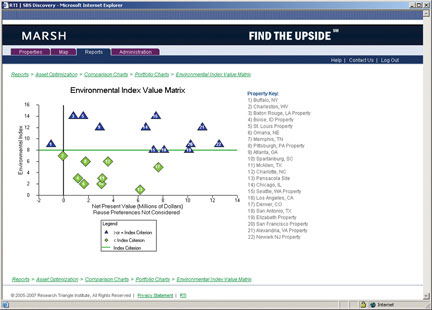

Divestiture Strategies
hevron‘s mergers with Texaco in 2001 and Unocal in 2005 left the San Ramon, Calif.- based oil giant with a considerable number of surplus properties. The company is now evaluating about 600 U.S. properties within its Legacy Property Management portfolio.
Some of these properties required environmental cleanup, and now that regulatory requirements have been met, Chevron is determining how best to dispose of them, says Jane Anderson, a program manager of the Superfund and Property Management office of Chevron Environmental Management Company. The properties range from former bulk fuel storage sites to agricultural chemical facilities to former refineries and fuel transfer facilities. They range in size from 10 to 500 acres (4 to 202 hectares), and most are in California and Texas.
Anderson leads a team using SBS Discovery, a Web- based software application now offered through a collaboration by risk and insurance services specialist Marsh and RTI International, a Research Triangle Park- based think tank. Chevron is the first large company to evaluate this new tool, which Anderson says uses existing environmental costs,

real estate values, redevelopment/community factors and market factors gathered by various Chevron operating companies.
Chevron is in the roll- out stage with SBS Discovery, gathering input from its real estate, public affairs and environmental groups. Anderson says Chevron’s properties may find a wide array of new uses, including wetland enhancement, residential and potential industrial projects, she says.
“We had been working off a series of Excel spreadsheets that wrapped the walls of my office, so I welcomed the idea of having everything organized into one tool,” Anderson says.
RTI provided details on how the trial is going on May 30. Anderson says she is very satisfied with the output of the model.
“The RTI effort was substantial and the quality of their work was phenomenal,” Anderson says.
RTI worked with Anderson’s staff to focus on a subset of 120 properties, whittled down from 583. Using the SBS Discovery tool, RTI prioritized how Chevron will move forward with these surplus properties.
“The 120 properties were defined as surplus, and we’ve decided to hold onto the other properties for now due to environmental or market factors,” Anderson says.
The next step will be to go through a pre- qualification process over the next few months with well- capitalized potential purchasers, Anderson says.
Glenn Osmond, business development manager for SBS Discovery, says its concept began more than two years ago when a major corporation approached RTI in search of a modeling and analysis tool to rank and analyze surplus properties to get them off its books.
“We began developing a prototype, but we stepped back to determine why this company was interested in such a tool,” Osmond says. “Was there a pervasive issue? We determined that many companies were beginning to reassess how they handled surplus properties with environmental challenges.”
Osmond says drivers of this trend included Sarbanes- Oxley compliance requirements and new accounting standards.
“We saw what had been developed by RTI offered great efficiencies to do what many of our clients were doing,” says Jim Vetter, a Marsh senior vice president.
Tony Marimpietri, RTI senior research director, says SBS Discovery is designed to work across thousands of properties and has great capacity for adding property details.
SBS Discovery allows a corporation’s management to determine answers to numerous key portfolio questions, including potential market values of assets, which reuse options are financially feasible, the true and hidden costs of ownership and environmental conditions and related risks.
Vetter says SBS Discovery, which is typically available on a three- year contract, allows executives to make appropriate portfolio decisions with a well- thought- out financial strategy. He says potential clients cover a broad industry and geographical base, but the most value is likely to be derived by corporations with large portfolios in need of developing strategies. He says it’s also applicable on the buy side for companies assessing properties they may wish to purchase.
Site Selection Online – The magazine of Corporate Real Estate Strategy and Area Economic Development.
©2007 Conway Data, Inc. All rights reserved. SiteNet data is from many sources and not warranted to be accurate or current.